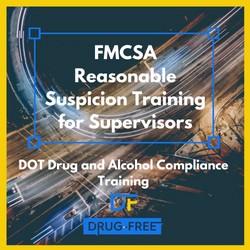DOT Supervisor Reasonable Suspicion Training Course is part of our DOT supervisor and DER training programs.
Make Decisions About DOT Reasonable Suspicion Testing
We discuss in DOT Supervisor Reasonable Suspicion Training how supervisors determine whether to do a drug test on reasonable suspicion.
We cover the role of evidence in making reasonable suspicion decisions.
And we explain how certain you must be to administer a drug test. Is a sneaking suspicion enough, or do you need more clear evidence? Your observations are an important part to the reasonable suspicion testing process, and we go over them in detail.
We discuss the standards of observations as well as how observations must be documented.
And we detail whether observations need to be present-time or in the past. We put an emphasis on current drug use over drug use in the past, and we explain why the distinction is important to the DOT reasonable suspicion testing process.
Present drug use is a greater safety risk than drug use in the past. Reasonable suspicion testing is more about safety than it is about punishment.
Know The Five Observable Signs of Current Drug and Alcohol Use
In reasonable suspicion testing, you need to recognize current drug and alcohol use. It is imperative for supervisors and DERs to notice an intoxicated employee who is performing “safety-sensitive” tasks.
It’s a dangerous scenario, and we lay out in detail the five major signs of current drug and alcohol use, and train you to pick up on them adeptly. There can’t be any oversight here!




